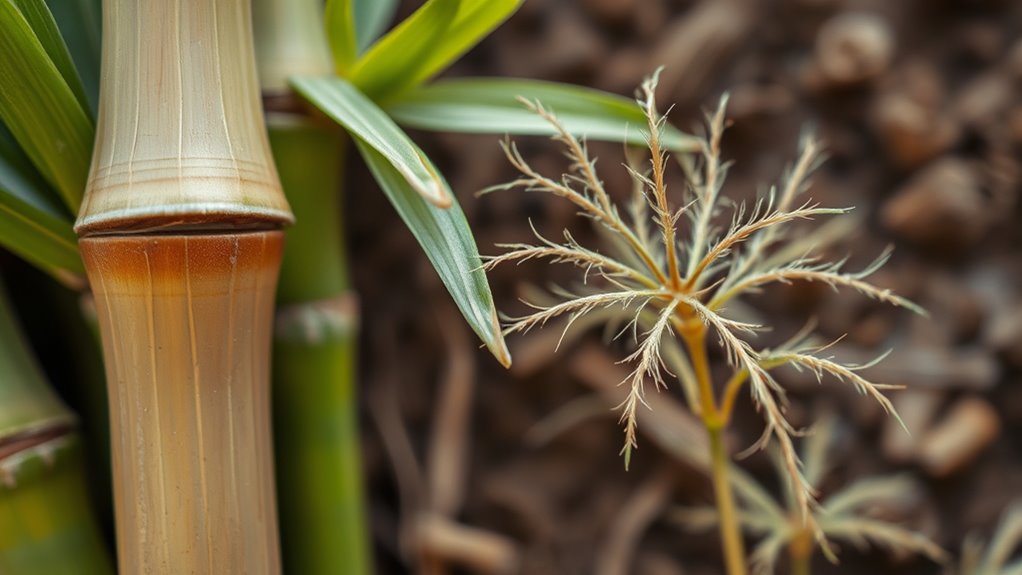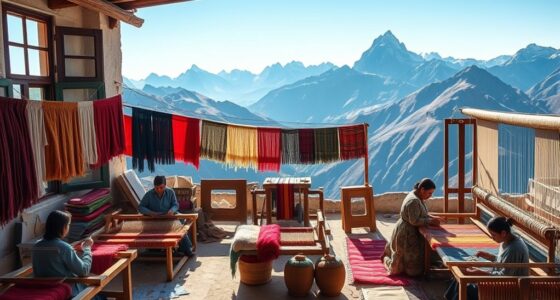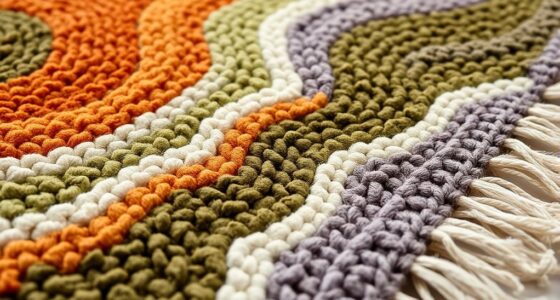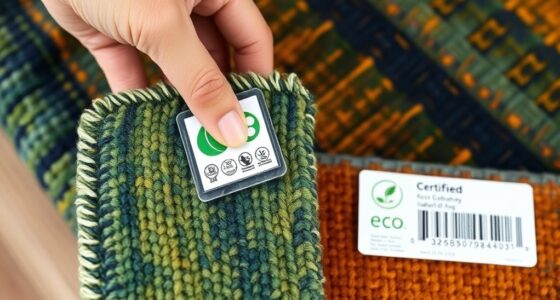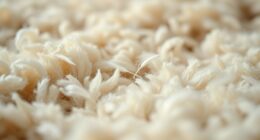When evaluating bamboo and nettle fibers as plant-based alternatives, you’ll find they offer eco-friendly benefits, like lower water use and biodegradable options. Bamboo provides silky, durable fibers suitable for textiles and construction, while nettle fibers become smoother after processing and are used traditionally in fabrics. Both have strong potential but face challenges like supply consistency and processing costs. Explore further to discover how innovations are shaping their role in sustainable industries.
Key Takeaways
- Bamboo and nettle fibers are sustainable, biodegradable, and environmentally friendly alternatives to conventional textiles, with low water and chemical use.
- Both fibers offer unique properties: bamboo is silky and high-strength; nettle is durable and eco-processed, suitable for various eco-friendly products.
- Processing techniques, including chemical treatments and blending, enhance fiber quality, strength, and suitability for high-quality applications.
- Challenges include supply chain inconsistencies, high harvesting costs, and specialized processing requirements, affecting large-scale market adoption.
- Innovations like biotechnology and genetic modification promise improved fiber strength and versatility, boosting future plant-based fiber utilization.
Characteristics and Properties of Bamboo and Nettle Fibers

Bamboo and nettle fibers are gaining attention as sustainable alternatives to traditional materials due to their unique characteristics. One notable feature is fiber fineness; bamboo fibers are generally fine, offering softness comparable to silk, while nettle fibers tend to be coarser but become smoother through processing. This fineness influences their texture and suitability for textiles. Additionally, these fibers display intriguing color variations—bamboo fibers often range from pale to golden hues, whereas nettle fibers can vary from natural beige to darker shades, adding visual interest. Both fibers are versatile, with bamboo providing a silky feel and high strength, and nettle offering durability and a distinctive appearance. Their natural color variations enhance their appeal for eco-friendly, artisanal, and fashion-forward applications. Moreover, fiber fineness is a key factor that impacts not only comfort but also the potential applications in various high-quality products, and understanding the natural properties of these fibers helps in optimizing their use. Exploring sustainable materials can further improve their integration into eco-conscious designs. Furthermore, advancements in processing techniques can enhance the fiber quality, making these fibers more competitive with conventional textiles.
Environmental Impact and Sustainability of Plant-Based Fibers
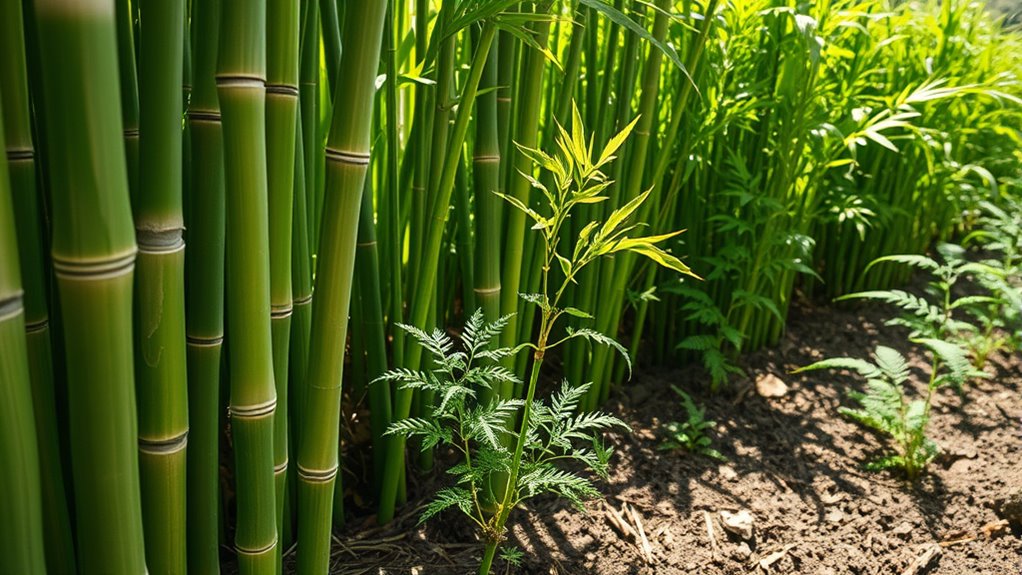
Plant-based fibers like bamboo and nettle are increasingly recognized for their environmental benefits compared to conventional textiles. They tend to have lower water consumption during cultivation, reducing strain on freshwater resources. However, biodegradability concerns remain, as some processing methods can hinder natural decomposition. Bamboo, when processed with eco-friendly techniques, biodegrades efficiently, but chemical treatments can slow this process. Nettle requires minimal chemical inputs and naturally decomposes without issues. Additionally, ensuring proper stewardship and sustainable practices during cultivation and processing further enhances their environmental advantages. Proper cultivation methods and sustainable processing techniques are vital to maximize their ecological benefits. Furthermore, adopting regenerative agriculture practices can help restore soil health and promote biodiversity in fiber cultivation. Implementing integrated pest management strategies can also reduce the need for chemical pesticides, further improving sustainability. Incorporating soil conservation methods can prevent erosion and maintain land productivity. Overall, these fibers offer a more sustainable alternative, especially when grown responsibly and processed sustainably. By choosing plant-based fibers, you contribute to reducing environmental impact, conserving water, and supporting biodegradable materials that lessen landfill waste. Proper cultivation and processing are key to maximizing their sustainability benefits.
Processing Techniques and Material Quality
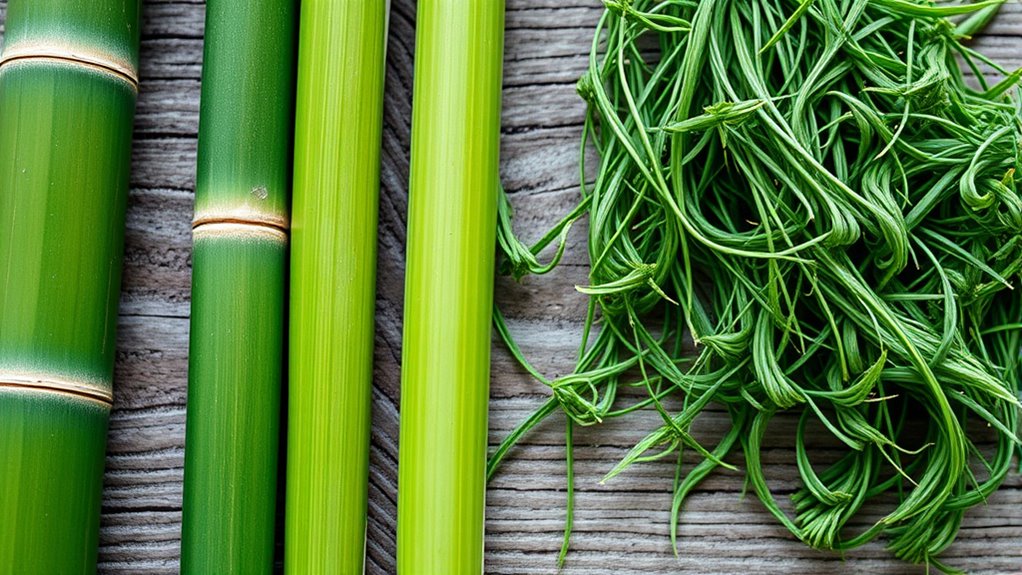
Processing techniques play a crucial role in determining the quality and performance of fibers like bamboo and nettle. Proper chemical treatments help remove impurities and enhance fiber strength, while fiber blending combines different fibers to improve properties such as texture and durability. These methods directly influence the final material quality, affecting texture, flexibility, and overall utility. Additionally, adhering to vetted processing standards ensures the fibers meet safety and sustainability criteria. Implementing advanced processing methods can further optimize fiber properties and ensure consistency across production batches. Monitoring performance metrics throughout processing can also identify areas for quality improvement and optimize the manufacturing process. Incorporating sustainable practices in processing not only benefits environmental goals but also boosts consumer confidence in eco-friendly materials.
Mechanical Strength and Durability Compared to Traditional Fibers
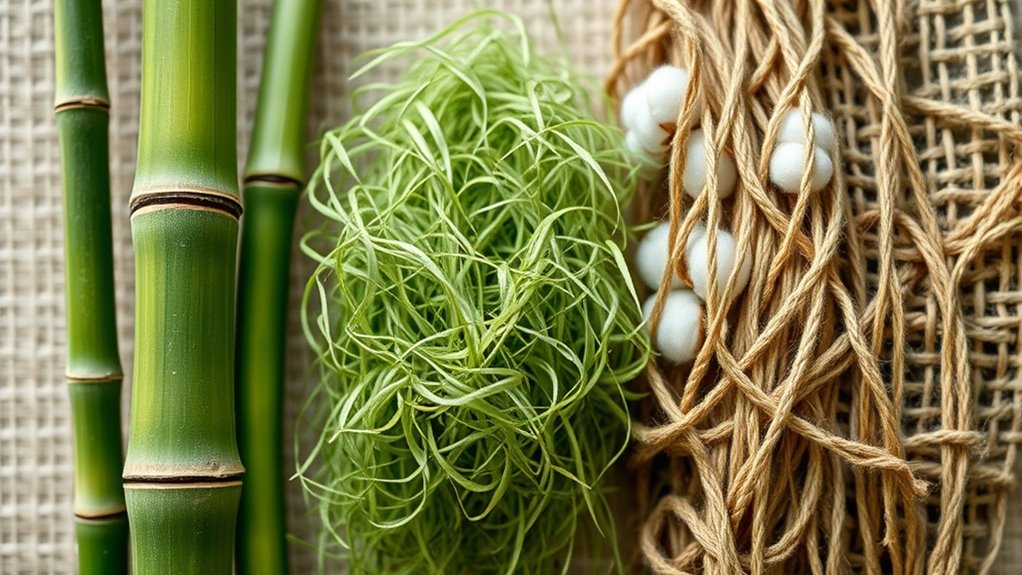
While traditional fibers like cotton and wool have long set the standard for strength and durability, plant-based fibers such as bamboo and nettle are increasingly competing in these areas. Their fiber tensile strength varies but can match or surpass conventional fibers with proper processing. You’ll notice that bamboo, for example, exhibits high wear resistance, making it suitable for demanding applications. Nettle fibers, while slightly less strong, still offer respectable durability due to their natural resilience. However, it is important to consider the environmental impact of their cultivation and processing, which can influence their overall sustainability and long-term viability. Proper processing techniques play a critical role in maximizing fiber strength and durability in these plants.
Applications and Industry Adoption of Bamboo and Nettle
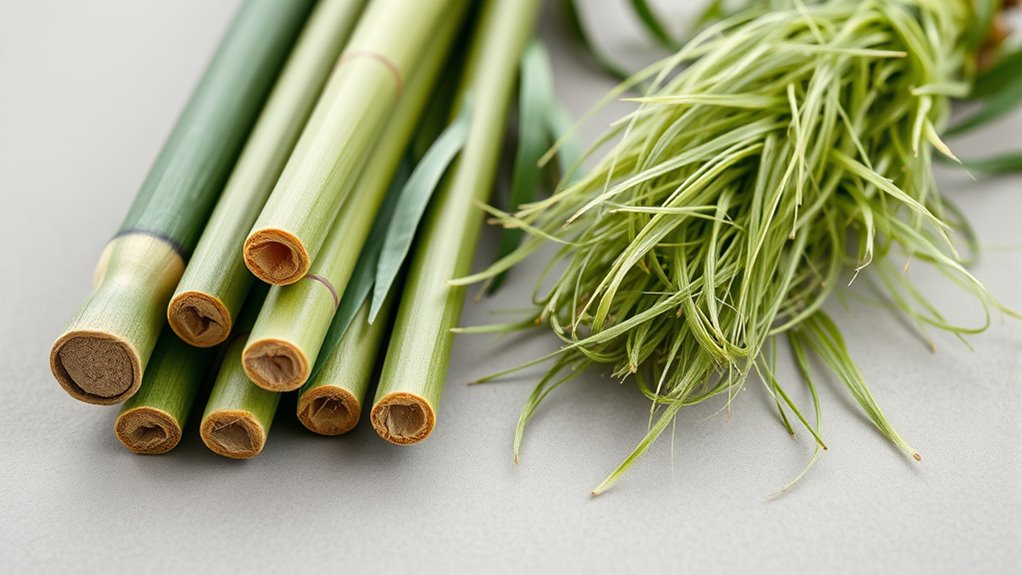
Bamboo and nettle fibers are gaining traction across various industries due to their combination of strength, sustainability, and versatility. These fibers hold cultural significance in many regions, reflecting traditional practices and local craftsmanship. Historically, bamboo has been used for building materials, textiles, and paper, while nettle fibers have served in producing ropes, fabrics, and cords. Today, industries are increasingly adopting these fibers for eco-friendly clothing, biodegradable packaging, and sustainable construction materials. Their natural appeal aligns with growing consumer demand for environmentally conscious products. As industries recognize their potential, the integration of bamboo and nettle into mainstream manufacturing continues to expand, supported by their rich cultural legacy and proven historical usage. This adoption signals a shift toward more sustainable, culturally rooted alternatives in various sectors.
Challenges and Limitations of Using Plant-Based Fibers
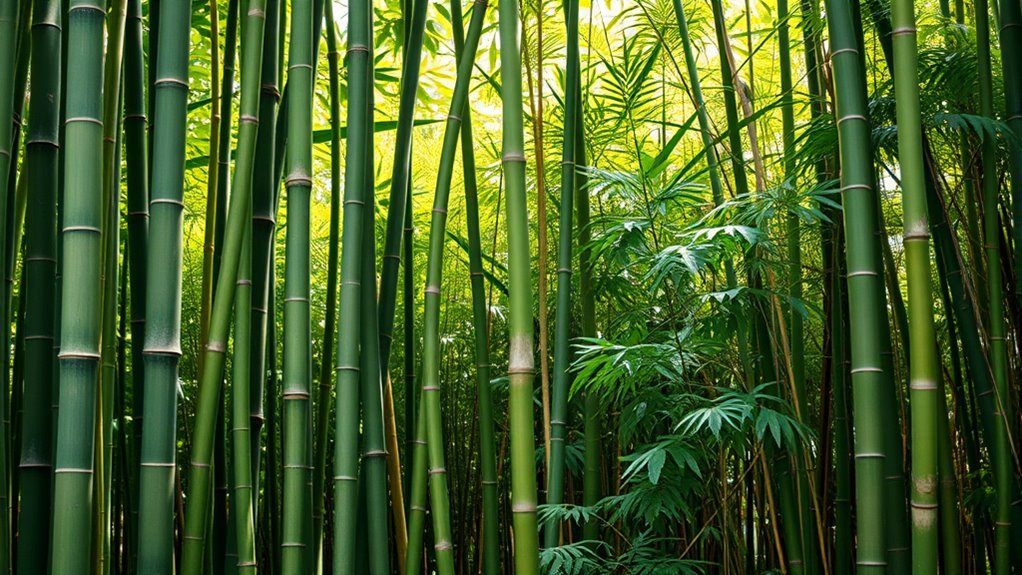
Despite their many benefits, plant-based fibers like bamboo and nettle face significant challenges that hinder widespread adoption. First, costly harvesting can limit profitability and increase prices, making them less competitive. Second, an inconsistent supply chain creates difficulties in meeting demand reliably. Third, processing plant fibers often requires specialized equipment and techniques, raising costs further. Fourth, environmental factors such as pests and climate variability can disrupt cultivation, reducing fiber quality and availability. Additionally, a lack of industry-standard techniques for processing these fibers can further impede their commercial viability. These issues highlight that, despite their advantages, plant-based fibers aren’t yet ready for mass-market integration without addressing these core limitations. Overcoming costly harvesting, stabilizing the supply chain, and improving processing methods are essential steps toward broader acceptance and sustainable use of bamboo and nettle fibers. Moreover, fiber quality control remains a challenge, affecting consistency and consumer confidence in these materials. Addressing these hurdles will require concerted research efforts and investment in developing standardized processing methods to ensure reliable, high-quality fiber production.
Economic Considerations and Market Potential
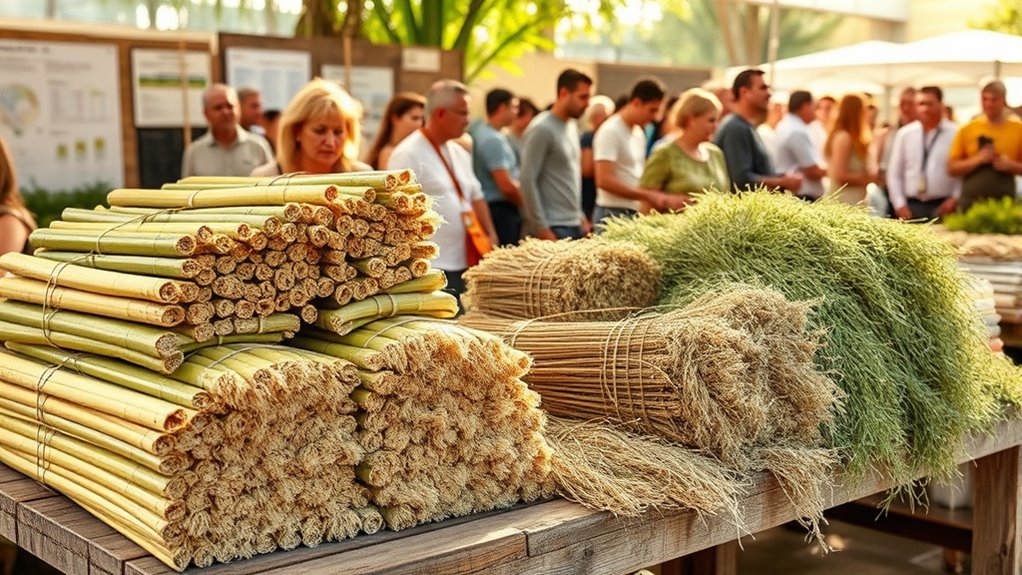
Evaluating the economic viability and market potential of plant-based fibers reveals promising opportunities for growth, but also significant hurdles to overcome. You’ll find that market entry can be challenging due to existing industry dominance and consumer preferences. However, the rising demand for sustainable products opens investment opportunities in cultivation, processing, and product development. As awareness of bamboo and nettle’s eco-friendly benefits spreads, businesses can capitalize on niche markets and premium pricing. To succeed, you’ll need to navigate supply chain logistics, scalability issues, and initial capital costs. Despite these challenges, the long-term market potential remains strong, driven by increasing environmental regulations and consumer shifts toward sustainable alternatives. Strategic investments now can position you advantageously in this emerging sector.
Future Perspectives and Innovations in Plant Fiber Utilization
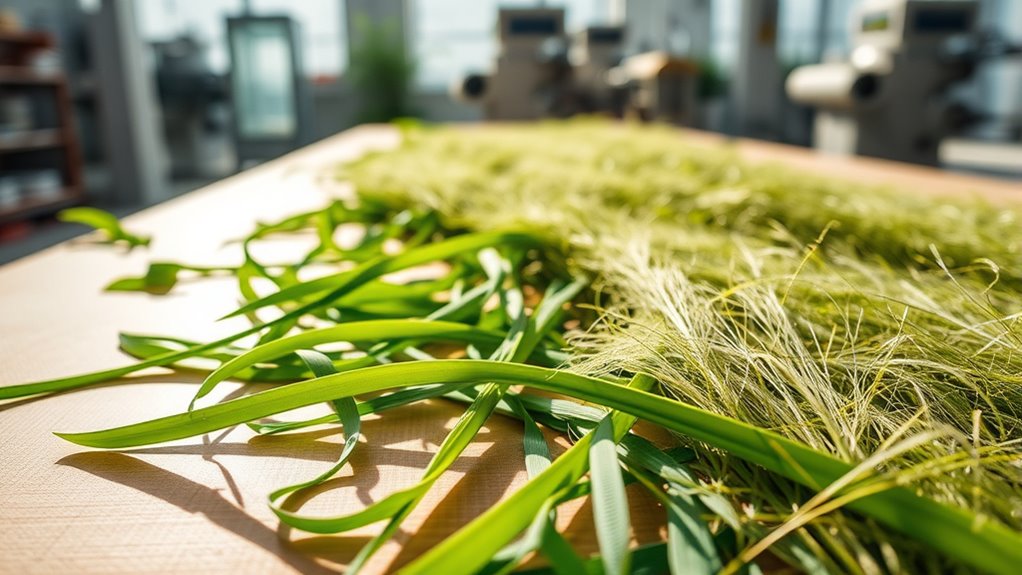
Looking ahead, innovations in plant fiber utilization are poised to reshape sustainable manufacturing and product development. Advances like genetic modification can enhance fiber strength, growth rate, and environmental resilience, making plant fibers more viable. You’ll see a growing recognition of cultural significance, as traditional uses of fibers like bamboo and nettle influence modern applications, preserving heritage. Innovations may include developing tailored fibers for specific industries, reducing reliance on synthetic materials. Additionally, integrating biotechnology could liberate new fiber properties, improving durability and versatility. These developments will likely foster eco-friendly products with higher performance. As you explore future options, consider how these technological and cultural shifts will drive the adoption of plant fibers, making sustainable choices more accessible and impactful across industries.
Frequently Asked Questions
How Do Bamboo and Nettle Fibers Compare in Cost to Synthetic Fibers?
You might wonder how bamboo and nettle fibers compare economically to synthetic fibers. Generally, natural fibers like bamboo and nettle are less cost-effective due to limited market accessibility and higher production costs, which impact their economic viability. Synthetic fibers benefit from established manufacturing processes and widespread availability, making them cheaper. However, as demand for sustainable options grows, the costs of bamboo and nettle fibers could decrease, improving their market competitiveness.
What Are the Health and Safety Considerations During Fiber Processing?
Imagine working with fibers that could cause your skin to erupt or your lungs to scream! During processing, you need to prioritize worker safety by minimizing chemical exposure, which can be intense and hazardous. Use proper protective gear, make certain good ventilation, and handle chemicals carefully. Overlooking these safety measures risks serious health issues, so stay vigilant, follow safety protocols, and keep the environment safe for everyone involved.
Are There Any Cultural or Regional Factors Influencing Fiber Adoption?
You should consider cultural acceptance and regional availability when adopting plant-based fibers. Cultural acceptance influences how willing communities are to embrace new materials like bamboo or nettle, which can vary widely based on traditions and perceptions. Regional availability affects supply and cost, making some fibers more practical in specific areas. Understanding these factors helps you choose fibers that align with local preferences and resources, ensuring successful adoption and sustainable use.
How Do Plant Fibers Perform in Extreme Weather Conditions?
Imagine your fiber’s strength as a fortress amid storms—that’s weather resilience in action. Plant fibers like bamboo and nettle vary in fiber durability; some withstand extreme weather, bending without breaking, while others may falter under intense heat or cold. You’ll find bamboo excels with high weather resilience, but nettle’s fiber durability can diminish in harsh conditions. Choose wisely, knowing each fiber’s unique battle against nature’s fury.
What Are the Potential Allergenic Effects of Bamboo and Nettle Fibers?
You might experience allergenic reactions when handling bamboo or nettle fibers, especially if you’re sensitive to plants in the same family. There’s a potential for cross-reactivity, meaning your immune system could react to similar proteins in these fibers. Always test a small area first and check for symptoms like itching or rash. If you have plant allergies, consult with an allergist before using products made from bamboo or nettle fibers.
Conclusion
While some may worry about durability, bamboo and nettle fibers prove to be strong, sustainable alternatives. Their eco-friendly cultivation, combined with growing industry interest, makes them promising options for various applications. Embracing these plant-based fibers doesn’t mean sacrificing quality; instead, it offers innovative solutions aligned with environmental goals. By supporting their development, you help foster a greener future without compromising performance or industry needs.
